Growing up in my Kapampangan Lola's kitchen, Pork Bulanglang was always our family's comfort food secret weapon: not your usual sinigang sa sampalok, but something even more special.
Every time I cook this guava-based soup now, the subtle sweet-sour broth instantly takes me back to weekend lunches in Pampanga, where the whole family would gather around the table, rice cooker always ready for second (or third!) helpings.
While tamarind sinigang will always have its place in Filipino cuisine, this Kapampangan version with its gentle sourness from bayabas hits differently. It's like a warm hug in a bowl, especially when the pork belly is melt-in-your-mouth tender and the kangkong is perfectly crisp.
After years of making this pork bulanglang recipe, I can tell you it's foolproof and absolutely worth trying, especially if you're looking to expand your sinigang expertise beyond the usual sampalok.
Jump to:
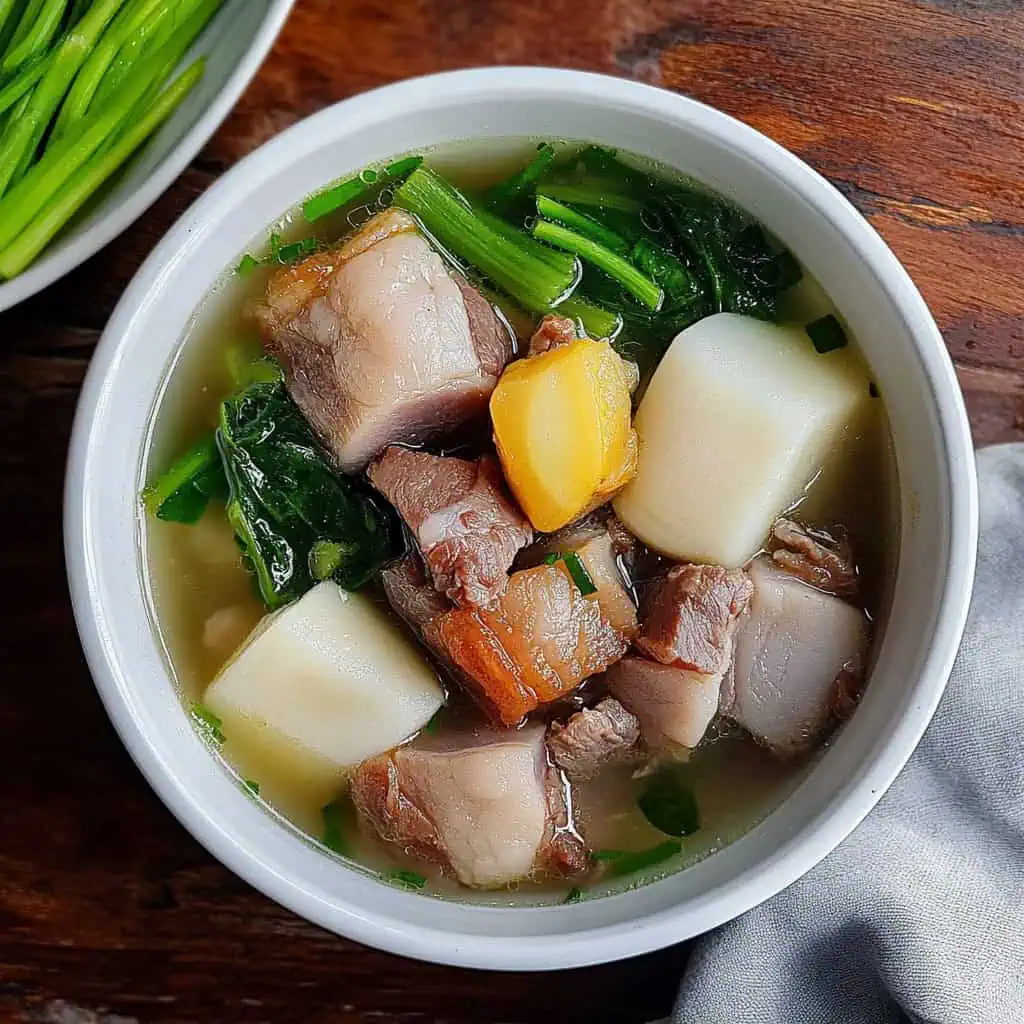
Why You'll Love This Recipe
- Unique Flavor Profile: Less tart than traditional tamarind sinigang, with subtle sweetness from guava
- One-Pot Meal: Complete nutrition with protein, vegetables, and soup
- Budget-Friendly: Uses affordable cuts of pork and common vegetables
- Authentically Kapampangan: A treasured regional variation of sinigang
- Versatile: Perfect for both rainy days and summer meals
Ingredients
The ingredients in this Pork Bulanglang create perfect harmony in traditional Kapampangan cooking. Pork belly provides rich flavor and tender texture, while guava delivers the signature gentle sourness that distinguishes this dish from regular sinigang.
Taro roots add hearty starchiness and natural thickening, and kangkong brings fresh crispness for textural contrast. Onions and fish sauce form a savory foundation that enhances the broth's depth without overpowering the delicate guava notes.
Together, these ingredients represent generations of Kapampangan cooking wisdom, creating a balanced soup that's simultaneously comforting, nutritious, and uniquely regional.
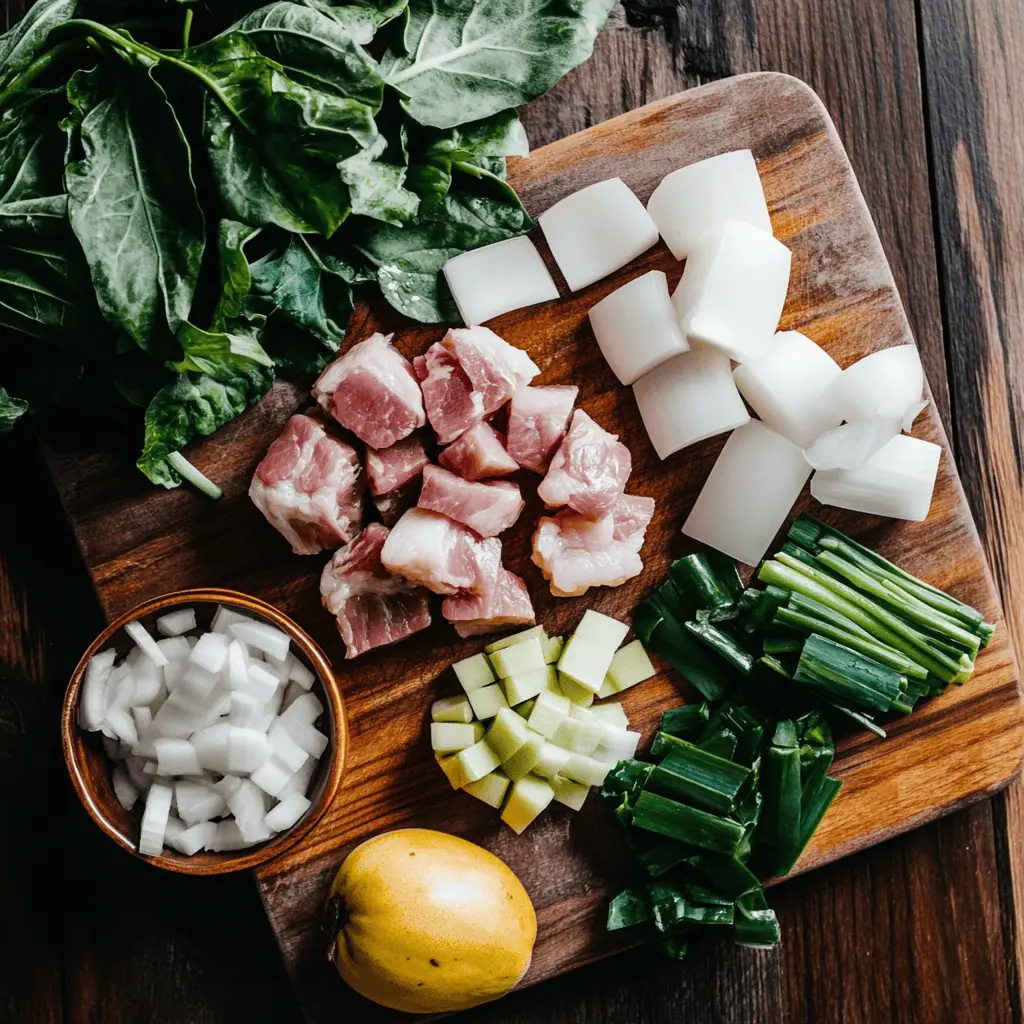
- 2 pounds pork belly, cut into 2-inch cubes
- 7 cups water
- 1 onion, peeled and quartered
- 1 tablespoon fish sauce
- 1 bunch water spinach (kangkong), separated into stalks and leaves
- 1 pound fresh guava (bayabas), about 10-12 pieces
- 8 pieces taro (gabi), peeled and cut into 2-inch chunks
- Salt to taste
Equipment
- Large Heavy-Bottom Pot (Kaldero): For even heat distribution and preventing scorching of the delicate soup base
- Fine-mesh strainer (Salaan): Essential for extracting the guava essence while keeping seeds and pulp out of your soup
- Sharp knife (Kutsilyo): Needed for properly cutting meat and vegetables to ensure even cooking
- Wooden spoon (Sandok na kahoy): Allows gentle stirring without scratching your pot and helps preserve the clarity of the broth
- Measuring cups and spoons (Panukat): Ensures the right balance of ingredients for authentic flavor
- Cutting board (Sangkalan): Provides a clean, stable surface for all preparation work
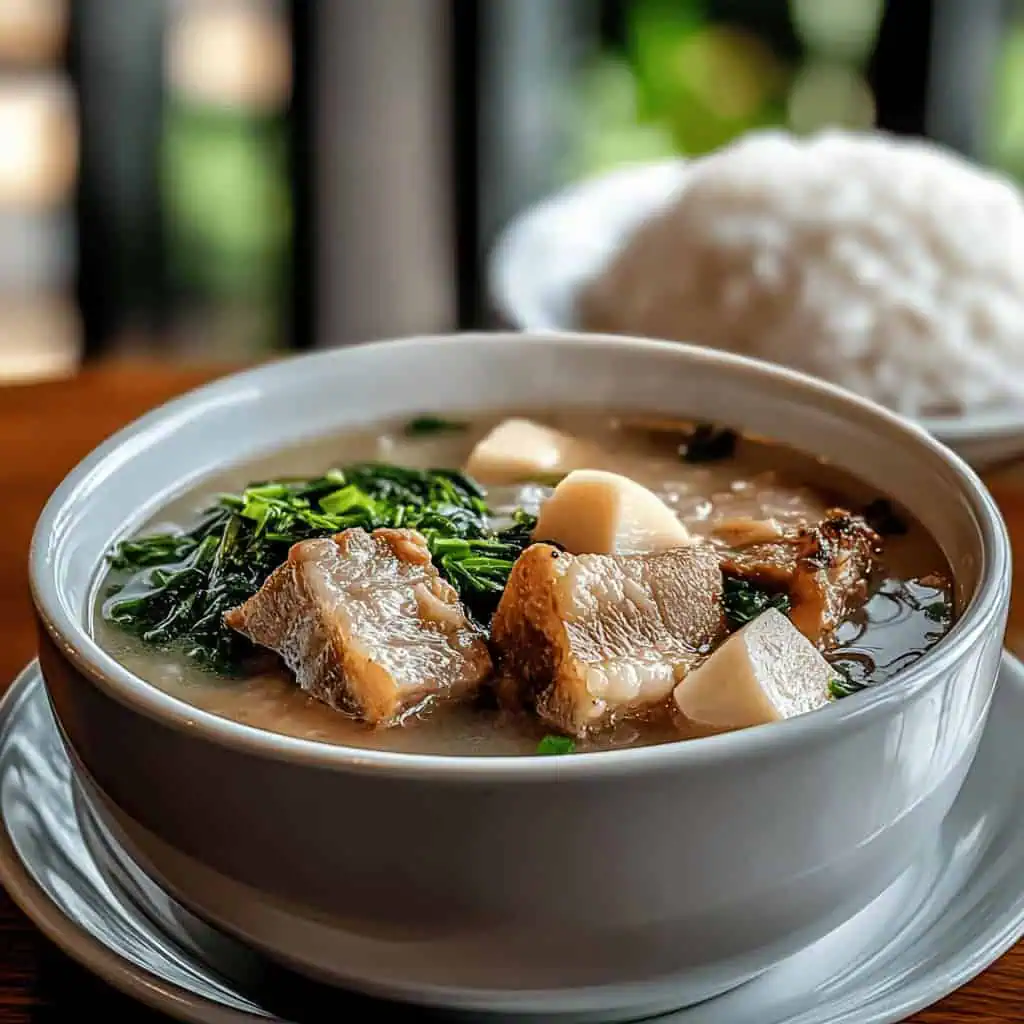
How To Make
- Begin by combining pork belly and water in a large heavy-bottomed pot over medium heat. Bring to a boil, carefully removing any scum that rises to the surface.
- Add quartered onions and fish sauce. Lower the heat to maintain a gentle simmer. Cover and cook for 1-1½ hours until the pork is tender, checking occasionally and adding hot water if needed.
- While the meat cooks, prepare the guava. Cut them in half and scoop out the seeds. Mash the seeds with 1 cup of water, then strain the mixture through a fine-mesh strainer to extract the sour essence.
- Once the pork is tender, add the peeled and cut taro and the guava halves. Cook for 5 minutes. Add the kangkong stalks first, cooking for 2 minutes before adding the leaves. Kangkong should remain crisp-tender.
- Season with salt to taste. If the broth is too sour, add a small piece of peeled potato to absorb excess sourness.
- Let the soup rest for 5 minutes before serving to allow the flavors to meld together perfectly.
- Serve hot with steaming white rice and optional patis-calamansi dipping sauce.

Tips from Lola's Kitchen
- Perfect Pork Selection: Choose pork belly with good fat marbling for richer flavor and more tender texture
- Guava Guidance: Look for guavas that are slightly firm but give when pressed—about 75% ripe is ideal
- Vegetable Vigilance: Don't overcook the kangkong—add it last and cook just until bright green for the perfect crisp-tender bite
- Clear Broth Secret: Keep skimming the surface during the initial boil to achieve that crystal-clear soup
- Sour Balance: If your guavas aren't sour enough, add a splash of calamansi or lemon juice to enhance the tartness
- Patience Pays Off: The longer you simmer the pork, the more flavorful your broth will become—don't rush this step
Substitutions
- Pork Cut: If pork belly isn't available, use pork ribs or shoulder for similar richness
- Kangkong Alternative: Regular spinach or morning glory works well in place of water spinach
- Taro Substitute: Sweet potatoes or regular potatoes can replace taro in a pinch
- Guava Options: Can't find fresh guavas? Try guava powder (adjust quantity to taste) or a mixture of green apples and lemon juice
- Fish Sauce Substitute: Regular salt works (adjust to taste) if fish sauce isn't available
- Onion Variety: Both red or white onions work fine—red onions add a slightly sweeter note
Troubleshooting
- Soup Too Sour:
- Add a small piece of peeled potato to absorb excess sourness
- Balance with a pinch more salt or a tiny bit of sugar
- Add more water to dilute the sourness
- Pork Not Tender Enough:
- Continue simmering on low heat until fork-tender
- Check water level frequently and add hot water if needed
- Consider cutting the pork into smaller pieces next time
- Broth Too Cloudy:
- Strain the broth through a fine-mesh strainer
- Return to a clean pot and continue cooking
- Be more diligent about skimming impurities during the initial boil
- Vegetables Overcooked:
- Add vegetables in stages according to cooking time needed
- Keep kangkong leaves separate and add them last
- Consider blanching vegetables separately and adding them to individual serving bowls
Storage & Reheating
- Refrigeration:
- Store in an airtight container for up to 3 days
- Keep broth and solids together for better flavor development
- Freezing:
- Freeze for up to 1 month (without kangkong)
- Leave some headspace in containers for expansion
- Freeze in portion-sized containers for easier reheating
- Reheating Methods:
- Stovetop: Reheat on medium-low heat until hot throughout
- Microwave: Use 2-3 minute intervals, stirring between to ensure even heating
- Add fresh kangkong when reheating for the best texture
- Flavor Enhancement:
- Add a splash of fish sauce when reheating to brighten flavors
- Fresh herbs or a squeeze of calamansi can revive day-old soup
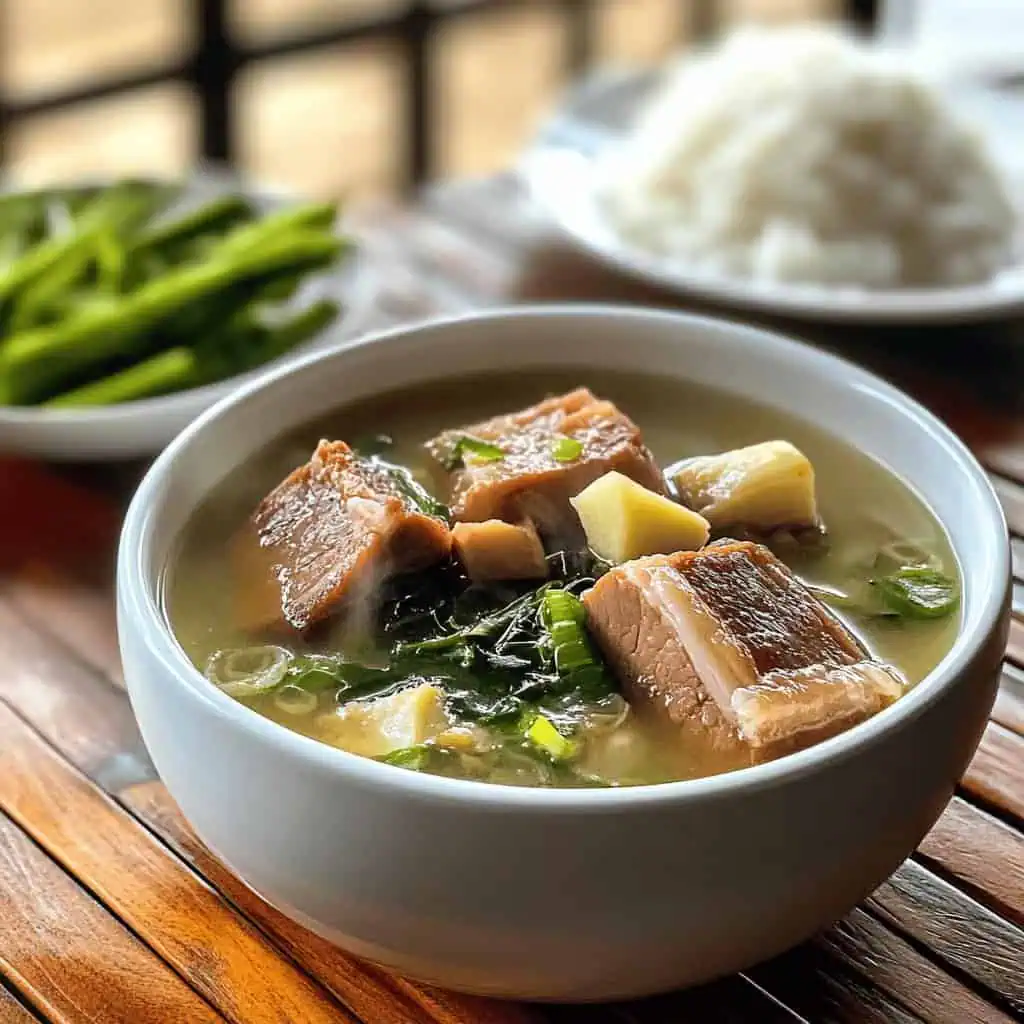
FAQ
Can I make this in advance for a party?
Yes! Actually, the flavors develop beautifully overnight. Make the soup base with pork and guava a day ahead, then add vegetables just before serving.
Why use guava instead of tamarind?
This is an authentic Kapampangan regional variation that offers a more delicate, nuanced sourness with subtle sweet notes that tamarind doesn't provide.
How do I know when the pork is done?
The pork should be fork-tender and easily pull apart when pressed with a spoon. Depending on the cut, this takes about 1-1½ hours of gentle simmering.
Can I use canned guava?
Fresh is definitely preferred, but canned can work in a pinch. Reduce the quantity by half and taste as you go since canned guavas are usually sweeter.
Is there a vegetarian version?
Yes! You can make bulanglang with mushrooms and extra vegetables. Use vegetable broth instead of the pork-based broth and add more taro for heartiness.
What makes this different from regular sinigang?
The guava creates a more subtle sourness with natural sweetness that tamarind doesn't have. The flavor profile is more nuanced and less sharp than traditional sinigang.
Can I make this in a slow cooker or pressure cooker?
Absolutely! For slow cooker: 4-6 hours on low. For pressure cooker: 30 minutes at high pressure with natural release. Add vegetables after pressure cooking.
What sides pair well with bulanglang?
Steamed rice is essential. Many also enjoy a side of bagoong alamang (shrimp paste) or patis with calamansi and chili for dipping the meat.
Related
Looking for other recipes like this? Try these:
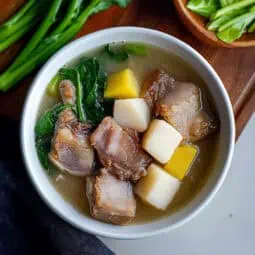
Pork Bulanglang (Kapampangan Sinigang sa Bayabas)
Equipment
- Large Heavy-Bottom Pot (Kaldero) For even heat distribution and preventing scorching
- Fine-mesh strainer (salaan) For straining guava pulp
- Sharp knife (kutsilyo) For cutting meat and vegetables
- Wooden spoon (sandok na kahoy) For gentle stirring without scratching the pot
- Measuring cups and spoons (Panukat) For accurate measurements
- Cutting board (Sangkalan) For preparation work
Ingredients
For the Soup Base:
- 2 pounds pork belly Liempo - cut into 2-inch cubes
- 7 cups water Tubig
- 1 onion Sibuyas, peeled and quartered
- 1 tablespoon fish sauce Patis
Vegetables and Fruits:
- 1 bunch water spinach Kangkong - separated into stalks and leaves
- 1 pound fresh guava Bayabas - about 10-12 pieces
- 8 pieces taro Gabi - peeled and cut into 2-inch chunks
Instructions
- Begin the initial preparation (paghahanda) by combining pork belly (liempo) and water (tubig) in a large heavy-bottomed pot (kaldero) over medium heat (katamtamang init). Bring to a boil, carefully removing any scum that rises to the surface.
- Add quartered onions (sibuyas) and fish sauce (patis). Lower the heat to maintain a gentle simmer. Cover and cook for 1-1½ hours until the pork is tender (lumambot), checking occasionally and adding hot water if needed.
- While the meat cooks, prepare the guava (bayabas). Cut them in half and scoop out the seeds. Mash the seeds with 1 cup of water, then strain the mixture through a fine-mesh strainer (salaan) to extract the sour essence.
- Once the pork is tender, add the peeled and cut taro (gabi) and the guava halves. Cook for 5 minutes. Add the kangkong stalks first, cooking for 2 minutes before adding the leaves. Kangkong should remain crisp-tender (malutong na malambot).
- Season with salt (asin) to taste. If the broth is too sour, add a small piece of peeled potato to absorb excess sourness. Serve hot with steaming white rice (mainit na kanin) and optional patis-calamansi dipping sauce.
- Let the soup rest for 5 minutes before serving to allow the flavors to meld together perfectly.
Tips from Lola's Kitchen
- Choose pork belly with good fat marbling for better flavor
- Look for guavas that are slightly firm but give when pressed
- Don't overcook the kangkong - it should remain crisp-tender
- Keep the broth clear by skimming regularly
- The best guavas for this dish are those that are 75% ripe
Nutrition
The Story Behind Pork Bulanglang (Kapampangan Sinigang sa Bayabas)
In the heart of Pampanga, known as the culinary capital of the Philippines, Pork Bulanglang stands as a testament to the region's innovative approach to Filipino cuisine. While most Filipinos are familiar with the sharp, tangy notes of traditional sinigang sa sampalok, this Kapampangan variation tells a different story through its use of native bayabas (guava) as the souring agent.
The term "bulanglang" itself showcases the fascinating diversity of Filipino regional cooking. In other provinces, bulanglang refers to a simple boiled vegetable dish with bagoong, but Kapampangans transformed it into their collective term for guava-based sour soups. This linguistic distinction reflects how deeply rooted this dish is in Pampanga's culinary identity.
What makes this recipe particularly special is how it emerged from the region's abundance of guava trees, which flourish in Pampanga's fertile soil. Local cooks discovered that the fruit's natural tartness, when combined with its subtle sweetness, created a more nuanced souring profile than the bold punch of sampalok (tamarind). This discovery led to the birth of various bulanglang dishes, with pork becoming the most beloved version.
Today, Pork Bulanglang continues to be a staple in Kapampangan households, especially during the guava season when trees are heavy with fruit. The dish represents the ingenuity of Filipino regional cooking, where local ingredients are transformed into distinctive dishes that carry the flavors of home. Whether served during family gatherings, rainy afternoons, or simple weekday meals, this soup remains a proud symbol of Pampanga's rich culinary heritage.
For modern Filipino home cooks, this recipe serves as a delicious gateway to exploring the depth and diversity of our regional cuisines. It's a reminder that beyond the well-known classics, there are countless local variations waiting to be discovered and shared with the next generation of Filipino food enthusiasts.
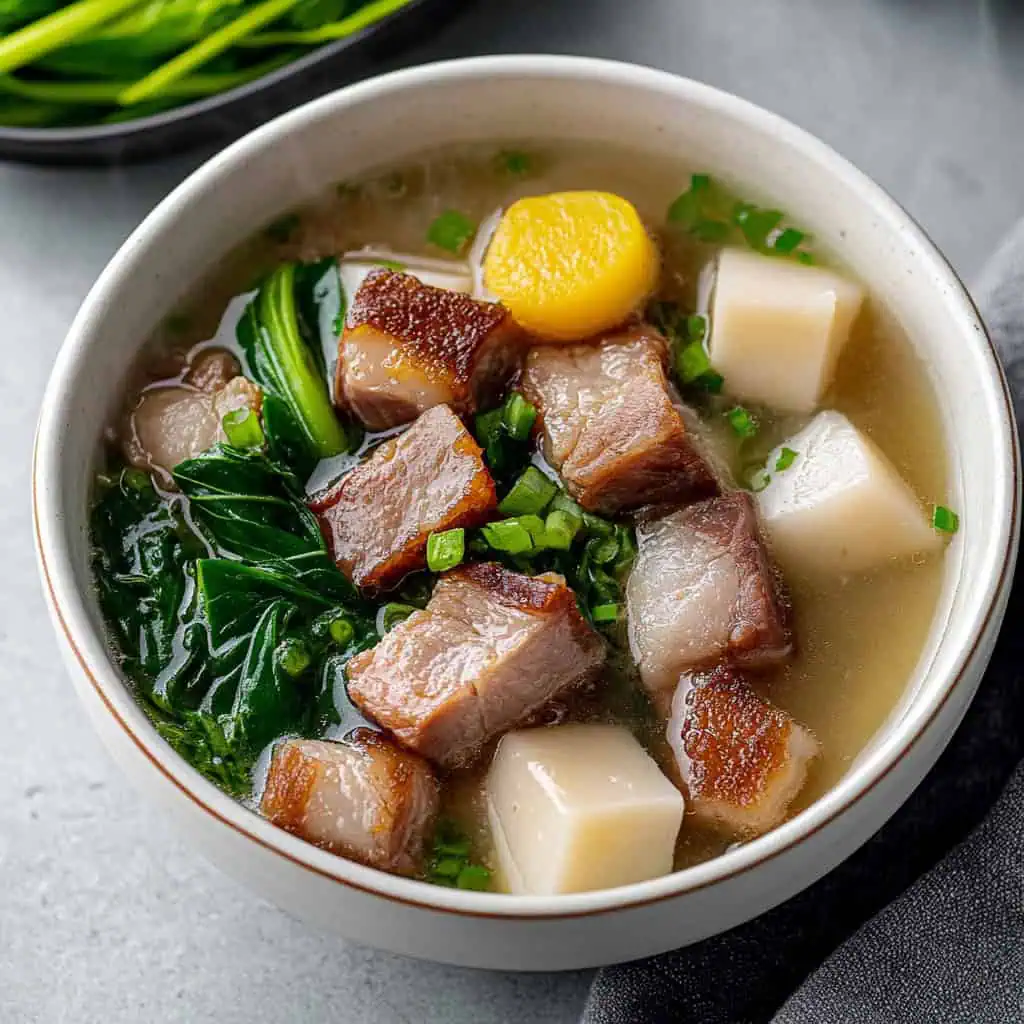









Comments
No Comments